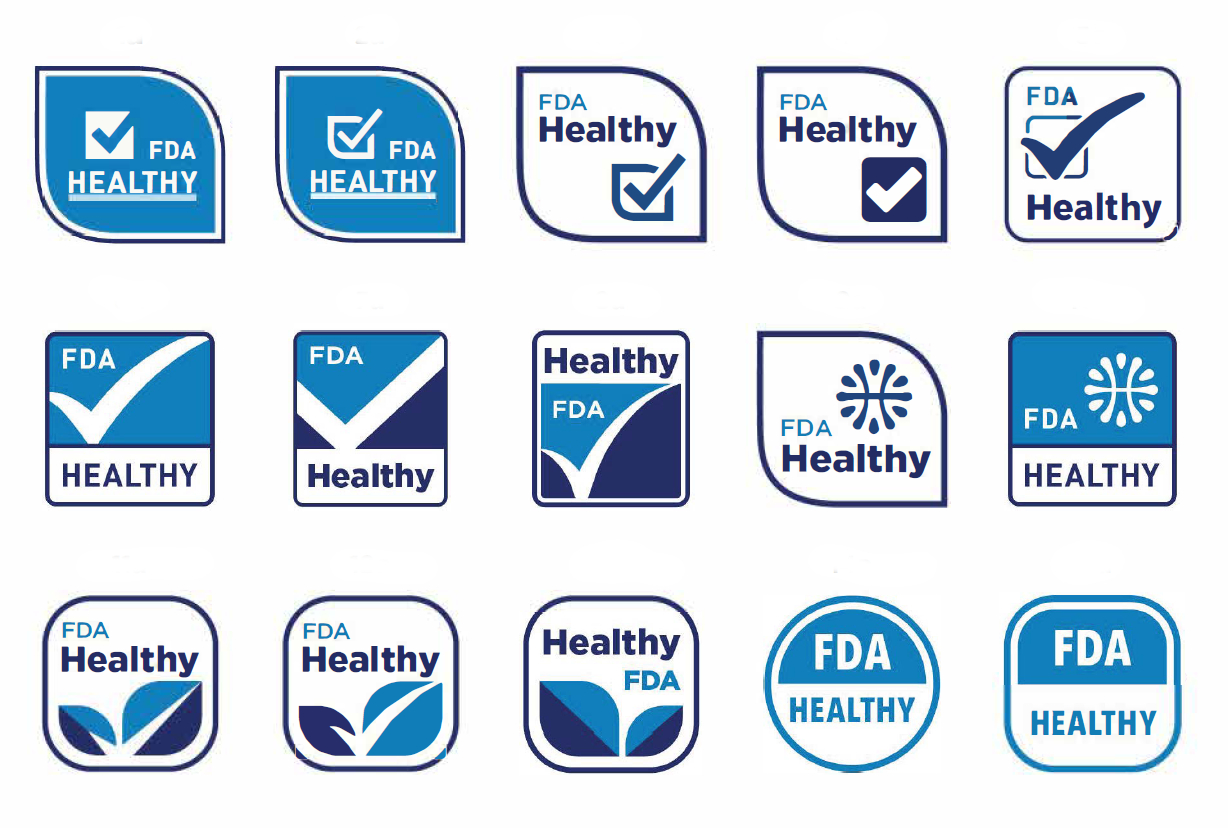U.S. News
18 Major Differences Between the FDA’s Original and Updated ‘Healthy’ Food Definitions
By Jake Beardslee · December 25, 2024

The FDA’s revised criteria for the “healthy” label require foods to contain significant amounts of recommended food groups like vegetables, fruits, dairy, protein, and whole grains, rather than focusing solely on individual nutrients like vitamin A or calcium. The new rules also impose stricter limits on saturated fat, sodium, and added sugars while removing outdated restrictions on total fat and dietary cholesterol. Food and Drug Administration


1. Focus on Food Groups Over Nutrients
Original: Foods had to contain a minimum amount of specific nutrients like vitamin A, vitamin C, calcium, or fiber.Updated: Foods now need to contribute to a recommended food group (e.g., vegetables, fruits, grains, dairy, or protein).
Why It Matters: This shift encourages a holistic approach to nutrition by focusing on diverse food groups rather than singling out individual nutrients, making it easier for consumers to identify truly nutrient-rich foods. As the FDA states, “Current dietary guidance recommends constructing healthy dietary patterns by eating an array of vegetables, fruits, dairy, protein foods, and whole grains to support nutrient adequacy.” Vanessa Loring / Pexels

2. Added Sugars Limits Introduced
Original: There were no restrictions on added sugars. Foods high in sugar could still qualify as "healthy" if they were fortified.Updated: Foods must now adhere to strict added sugar limits, aligning with the Dietary Guidelines for Americans.
Why It Matters: Excess sugar is a leading contributor to chronic conditions like obesity and diabetes. The FDA explains, “The U.S. faces an ever-growing epidemic of preventable diet-related chronic diseases such as cardiovascular disease, type 2 diabetes and obesity. Improving nutrition is one of the best public health interventions for reducing these and other chronic illnesses and premature death." Suzy Hazelwood / Pexels

3. Dietary Cholesterol Limits Removed
Original: Foods were required to stay under a certain cholesterol threshold.Updated: Dietary cholesterol restrictions have been removed, reflecting updated science that shows cholesterol intake has less impact on heart health than previously thought.
Why It Matters: This change recognizes the nutritional value of cholesterol-rich foods like eggs, which can now be labeled as "healthy." BorisTM / Pexels

4. Eggs: A Nutritional Comeback Under FDA’s New “Healthy” Guidelines
Original: Eggs were excluded from the “healthy” label due to their cholesterol content and strict limits on total fat. Foods high in dietary cholesterol were automatically disqualified under the old definition, regardless of their other nutritional benefits.Updated: Eggs now qualify as “healthy” under the FDA’s revised guidelines, which eliminate restrictions on dietary cholesterol and total fat.
Why It Matters: This change reflects the latest science showing that dietary cholesterol has little effect on blood cholesterol levels for most people. Eggs are a nutrient-dense, versatile option that provide high-quality protein and essential nutrients like vitamin D and choline. As Jen Houchins of the Egg Nutrition Center noted, “This news makes eggs a clear healthy choice, vindicating them from outdated science.” Pixabay / Pexels

5. Total Fat Restrictions Eliminated
Original: Foods had to meet strict total fat limits to qualify, regardless of fat type.Updated: Focus is placed on reducing saturated fat while encouraging unsaturated fats.
Why It Matters: This aligns with modern research distinguishing between harmful saturated fats and beneficial unsaturated fats, found in foods like nuts, seeds, and avocados. The FDA notes, “Current dietary recommendations have moved away from specific limits for total fat and instead focus on limiting saturated fat and replacing it with unsaturated fat in the diet.” Anne / Pexels

6. Stricter Sodium Limits
Original: Sodium limits were more lenient, allowing higher amounts of salt in "healthy" foods.Updated: Sodium thresholds have been tightened to reflect current dietary recommendations.
Why It Matters: High sodium intake is linked to hypertension and cardiovascular diseases. Castorly Stock / Pexels

7. Minimum Nutrient Requirements Removed
Original: Foods needed to provide at least 10% of the daily value for one or more specific nutrients (e.g., vitamin C, calcium).Updated: There is no longer a focus on individual nutrients but rather the food’s contribution to overall dietary patterns.
Why It Matters: This encourages the consumption of whole, minimally processed foods that provide a range of nutrients naturally. The FDA emphasizes, "Current dietary guidance recommends constructing healthy dietary patterns by eating an array of vegetables, fruits, dairy, protein foods and whole grains to support nutrient adequacy of the diet. Focusing on food groups better reflects the overall nutrient content of a food rather than focusing on one individual beneficial nutrient in isolation.” Ella Olsson / Pexels

8. Inclusion of Nuts, Seeds, and Oils
Original: Foods like nuts, seeds, and oils were excluded due to their high fat content.Updated: These nutrient-dense foods are now recognized as essential components of a healthy diet.
Why It Matters: These foods are rich in unsaturated fats, protein, and other nutrients. As the FDA explains, foods such as "avocados, nuts and seeds, higher fat fish, such as salmon, and olive oil will now qualify to use the 'healthy' claim." cottonbro studio / Pexels

9. Prioritization of Fresh Produce
Original: Highly processed foods could qualify as "healthy" if fortified, while fresh produce was often overlooked.Updated: Fresh fruits and vegetables, as well as minimally processed versions, are now central to the "healthy" definition.
Why It Matters: This ensures that natural, nutrient-rich foods are recognized as the foundation of a healthy diet. Mark Stebnicki / Pexels

10. Broadening of Dairy Options
Original: Only low-fat dairy products were considered "healthy."Updated: Both fat-free and low-fat dairy are included, reflecting dietary preferences and nutritional variety.
Why It Matters: This change provides consumers with more options while maintaining a focus on nutrient-rich choices. The FDA explains, “Healthy eating patterns, which include foundational foods like...fat-free and low-fat dairy, and whole grains, are associated with improved health, such as reduced risk of cardiovascular disease, type 2 diabetes, certain types of cancers, and being overweight or obese.” Pixabay / Pexels

11. Recognition of Healthy Oils
Original: All oils were excluded from the "healthy" category due to their fat content.Updated: Healthy oils like olive oil now qualify due to their high levels of unsaturated fats and health benefits.
Why It Matters: This encourages the use of oils that are beneficial for heart health and overall well-being. Pixabay / Pexels

12. Inclusion of Water as a "Healthy" Choice
Original: Water was not included in the "healthy" definition, as it wasn’t considered a food.Updated: Plain water now qualifies as a "healthy" option, reflecting its importance in hydration and overall health.
Why It Matters: Promoting water consumption can help reduce reliance on sugary beverages, a key factor in diet-related health issues. Pixabay / Pexels

13. Trail Mix with Dried Fruits and Nuts
Original: Excluded due to the high fat content of nuts and seeds.Updated: Now qualifies if it meets added sugar and sodium limits.
Why It Matters: Trail mix provides a nutrient-dense snack option that can support a balanced diet. However, the FDA explains, "Nutritional content of these items may vary based on added ingredients and must meet a minimum food group amount and required limits for saturated fat, sodium, and added sugars to qualify to bear the 'healthy' claim under the updated definition." Towfiqu barbhuiya / Pexels

14. Higher Standards for Cereals
Original: Fortified cereals with significant added sugars could qualify as "healthy."Updated: Cereals must now contain whole grains and adhere to stricter limits on sugar and sodium.
Why It Matters: This ensures cereals marketed as "healthy" genuinely align with dietary guidelines. The FDA notes, “A cereal needs to contain a certain amount of whole grains and adhere to limits for saturated fat, sodium, and added sugars." Leah Newhouse / Pexels

15. Stricter Snack Bar Requirements
Original: Snack bars high in sugar could qualify if fortified with vitamins or minerals.Updated: Snack bars must now derive nutrients from whole ingredients like nuts, seeds, or grains.
Why It Matters: This eliminates reliance on fortification and promotes naturally nutrient-rich foods. Yaroslav Shuraev / Pexels

16. Consumer-Friendly Labeling
Original: Relied on back-label nutrition information, which could be confusing or ignored.Updated: The FDA plans to introduce a front-of-package “healthy” symbol to help consumers quickly identify qualifying products.
Why It Matters: Simplified labels empower consumers to make healthier choices more easily. The FDA explains, "Having a standardized graphic to show that a food meets the criteria for the 'healthy' claim would further support the FDA’s goal of helping consumers to identify food products that can be the foundation of healthy eating patterns." Food and Drug Administration

17. Incentives for Reformulation
Original: Provided little motivation for manufacturers to improve the nutritional quality of their products.Updated: Encourages reformulation to meet stricter criteria, potentially improving the overall food supply.
Why It Matters: This could lead to healthier options across a wider range of budgets. The FDA highlights, "Many foods that fit into a range of budgets such as some peanut butters and canned fruits and vegetables also qualify. Manufacturers who choose to use the 'healthy' claim have three years to conform but can use the new criteria sooner." Leeloo The First / Pexels

18. Less Emphasis on Fortification
Original: Heavily processed foods with minimal inherent nutritional value could qualify by adding nutrients artificially.Updated: Foods must naturally contribute to a balanced diet rather than rely on fortification.
Why It Matters: This encourages manufacturers to focus on producing inherently nutritious foods. The FDA explains, "Examples of products that qualified for “healthy” under the original claim that do not under the updated claim include fortified white bread, highly sweetened yogurt, and highly sweetened cereal." Binyamin Mellish / Pexels
